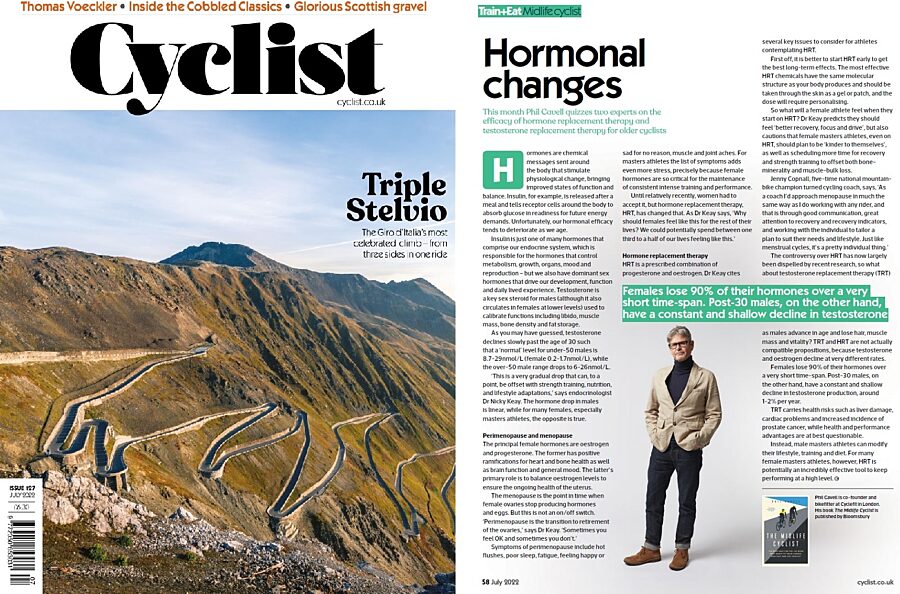"The hormone drop in males is linear, while for many females, especially masters athletes, the opposite is true."
Hormones - Your Body's Biological Text-Messages
Hormones are chemical messages sent around the body that stimulate physiological change, bringing improved states of function and balance. Insulin, for example, is released after a meal and tells receptor cells around the body to absorb glucose in readiness for future energy demands.
Unfortunately, our hormonal efficacy tends to deteriorate as we age. Insulin is just one of many hormones that comprise our endocrine system, which is responsible for the hormones that control metabolism, growth, organs, mood and reproduction – but we also have dominant sex
hormones that drive our development, function and daily lived experience. Testosterone is a key sex steroid for males (although it also circulates in females at lower levels) used to calibrate functions including libido, muscle mass, bone density and fat storage. As you may have guessed, testosterone declines slowly past the age of 30 such that a ‘normal’ level for under-50 males is
8.7-29nmol/L (female 0.2-1.7nmol/L), while the over-50 male range drops to 6-26nmol/L.
‘This is a very gradual drop that can, to a point, be offset with strength training, nutrition,
and lifestyle adaptations'
says endocrinologist Dr Nicky Keay.
The hormone drop in males is linear, while for many females, especially masters athletes, the opposite is true.
"Why should females feel like this for the rest of their lives? We could potentially spend between one third to a half of our lives feeling like this"
Perimenopause and Menopause
The principal female hormones are oestrogen and progesterone. The former has positive ramifications for heart and bone health as well as brain function and general mood. The latter’s primary role is to balance oestrogen levels to ensure the ongoing health of the uterus. The menopause is the point in time when
female ovaries stop producing hormones and eggs. But this is not an on/off switch.
‘Perimenopause is the transition to retirement of the ovaries,’ says Dr Keay.
‘Sometimes you feel OK and sometimes you don’t.’
Symptoms of perimenopause include hot flushes, poor sleep, fatigue, feeling happy or sad for no reason, muscle and joint aches. For masters athletes the list of symptoms adds even more stress, precisely because female hormones are so critical for the maintenance of consistent intense training and performance.
Until relatively recently, women had to accept it, but hormone replacement therapy, HRT, has changed that. As Dr Keay says:
‘Why should females feel like this for the rest of their lives? We could potentially spend between one
third to a half of our lives feeling like this.’
"Post-30 males have a constant and shallow decline in testosterone production, around 1-2% per year."
Hormone Replacement Therapy
HRT is a prescribed combination of progesterone and oestrogen. Dr Keay cites several key issues to consider for athletes contemplating HRT.
First off, it is better to start HRT early to get the best long-term effects. The most effective HRT chemicals have the same molecular structure as your body produces and should be taken through the skin as a gel or patch, and the dose will require personalising.
So what will a female athlete feel when they start on HRT? Dr Keay predicts they should feel ‘better recovery, focus and drive’, but also cautions that female masters athletes, even on
HRT, should plan to be ‘kinder to themselves’, as well as scheduling more time for recovery
and strength training to offset both bone minerality and muscle-bulk loss.
Jenny Copnall, five-time national mountain bike champion turned cycling coach, says:
‘As a coach I’d approach menopause in much the same way as I do working with any rider, and
that is through good communication, great attention to recovery and recovery indicators, and working with the individual to tailor a plan to suit their needs and lifestyle. Just like menstrual cycles, it’s a pretty individual thing.’
What About TRT Chaps?
The controversy over HRT has now largely been dispelled by recent research, so what about testosterone replacement therapy (TRT) as males advance in age and lose hair, muscle mass and vitality?
TRT and HRT are not actually compatible propositions, because testosterone and oestrogen decline at very different rates. Females lose 90% of their hormones over a very short time span. Post-30 males, on the other hand, have a constant and shallow decline in testosterone production, around 1-2% per year. TRT carries health risks such as liver damage, cardiac problems and increased incidence of prostate cancer, while health and performance advantages are at best questionable. Instead, male masters athletes can modify their lifestyle, training and diet. For many female masters athletes, however, HRT is potentially an incredibly effective tool to keep performing at a high level.
Phil Cavell is co-founder and bikefitter at Cyclefit in London. His book The Midlife Cyclist is published by Bloomsbury. This Column was first published in Cyclist Magazine - July 2022 and is re-printed here with their kind permission.


